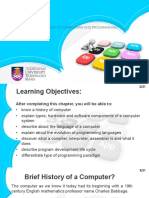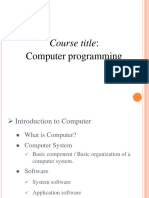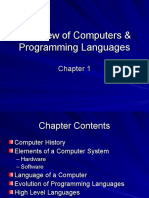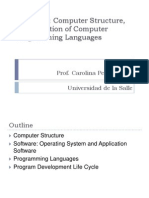0 ratings0% found this document useful (0 votes)
226 viewsLesson 1 Programming
This document provides an introduction to computer programming. It discusses the input-process-output approach used in systems to transform input data into output. Input refers to entered data, process is any procedures performed, and output is the resulting outcome. The document also defines computer programs, programming, and programmers. It classifies programming languages and discusses the software development life cycle.
Uploaded by
Nelson PiconesCopyright
© © All Rights Reserved
Available Formats
Download as PPTX, PDF, TXT or read online on Scribd
0 ratings0% found this document useful (0 votes)
226 viewsLesson 1 Programming
This document provides an introduction to computer programming. It discusses the input-process-output approach used in systems to transform input data into output. Input refers to entered data, process is any procedures performed, and output is the resulting outcome. The document also defines computer programs, programming, and programmers. It classifies programming languages and discusses the software development life cycle.
Uploaded by
Nelson PiconesCopyright
© © All Rights Reserved
Available Formats
Download as PPTX, PDF, TXT or read online on Scribd
You are on page 1/ 9
Lesson 1: Introduction to
Computer Programming
The Input-Process-Output (IPO) Approach
The Input-Process-Output (IPO) is a pattern or
approach that is widely used in systems for
transforming input data into output. This is used
to describe the structure of process.
Input- is any data entered into the computer
system. It could be resources such as people,
item details, or finance that are entered into
the system to obtain a desired output.
Process- a procedure being taken to provide
an output.
Output- serves as the outcome of the process.
It also meets the goal or end result of the
entire procedure.
Point-of-Sale (POS)
• System that is commonly used in a grocery or
a department store, checkout counter, identify
the information needed, information to be
processed, and expected outcome of the
system.
Computer Program
• Is a series of instructions written to perform a specified task
on a computer.
Programming- the art and science of creating programs
Programmer- the person who write, develops and debugs a
computer program.
Programming language- a tool that is used by the
programmer to communicate with the computer. It allows
programmers to write commands or instructions that can be
easily understood by a person and translated into codes that
are machibe-readable.
Classification of Programming
Language
1. The machine language- a computer is an electronic
machine; it can only feel electricity and is designed to
work with information
• Binary language/machine language- the only language
that can be used in the computer, uses only 2 numbers,
1 and 0.
Binary numeral system- represents and processes
numbers using binary digits 0 and 1 which represented
by ‘on’ and ‘off’. This has 2 as a base.
Decimal numeral system- represents numbers
understood by humans and it is composed of 0 to 9.
this number has 10 as a base.
2. The Assembly Language
• More advanced than the machine language as
it uses mnemonics in place of machine codes
to simplify the programmer’s way of creating
programs.
Mnemonics- are memory aids. It uses English
like abbreviation.
Assembler- the program that requires another
program to translate mnemonics into machine
code.
3. The High-level Language
• Allow programmers to use English commands to carry out
instructions.
Interpreter- translates high-level instructions line by line
into machine code during runtime.
Compiler- translates the entire program into machine code
before the program executes.
Object-oriented programming language- is a high-level
programming language that uses GUI-based interfaces
Object-oriented programming (OOP) and event driven
programming languages- with these languages, the
emphasis of creating a program was on the objects
included in the user interface like buttons and scrollbars.
Software Development Life Cycle
(SDLC)
• The process used in creating computer
systems. It consists of a detailed plan
describing how to develop and maintain
systems.
Stages in Software Development
• requirements-
• Planning/Design
• Implementation
• Testing and Debugging
• Deployment
• Support and Maintenance
You might also like
- Hourglass Workout Program by Luisagiuliet 276% (21)Hourglass Workout Program by Luisagiuliet 251 pages
- Read People Like A Book by Patrick King-Edited57% (82)Read People Like A Book by Patrick King-Edited12 pages
- Livingood, Blake - Livingood Daily Your 21-Day Guide To Experience Real Health77% (13)Livingood, Blake - Livingood Daily Your 21-Day Guide To Experience Real Health260 pages
- Donald Trump & Jeffrey Epstein Rape Lawsuit and Affidavits83% (1016)Donald Trump & Jeffrey Epstein Rape Lawsuit and Affidavits13 pages
- The 36 Questions That Lead To Love - The New York Times91% (35)The 36 Questions That Lead To Love - The New York Times3 pages
- The 36 Questions That Lead To Love - The New York Times95% (21)The 36 Questions That Lead To Love - The New York Times3 pages
- Jeffrey Epstein39s Little Black Book Unredacted PDF75% (12)Jeffrey Epstein39s Little Black Book Unredacted PDF95 pages
- 14 Easiest & Hardest Muscles To Build (Ranked With Solutions)100% (8)14 Easiest & Hardest Muscles To Build (Ranked With Solutions)27 pages
- The 4 Hour Workweek, Expanded and Updated by Timothy Ferriss - Excerpt23% (954)The 4 Hour Workweek, Expanded and Updated by Timothy Ferriss - Excerpt38 pages
- GET214 Lesson0 - Introduction to ComputingNo ratings yetGET214 Lesson0 - Introduction to Computing6 pages
- Topic 1 - Introduction To Computers and Programming PDFNo ratings yetTopic 1 - Introduction To Computers and Programming PDF37 pages
- INTRODUCTION - Concepts and Principles in Programming100% (7)INTRODUCTION - Concepts and Principles in Programming9 pages
- CHAPTER 11 - Introduction to Programming LanguagesNo ratings yetCHAPTER 11 - Introduction to Programming Languages17 pages
- Understanding Computer Programming 9&10No ratings yetUnderstanding Computer Programming 9&1053 pages
- JK VB NET 1 Introduction To Visual Basic NET Background and PerspectiveNo ratings yetJK VB NET 1 Introduction To Visual Basic NET Background and Perspective41 pages
- Chapter 1-Introduction To Computer and ProgrammingNo ratings yetChapter 1-Introduction To Computer and Programming11 pages
- Murach C# Lecture 1 Slides BTM380 ProgrammingNo ratings yetMurach C# Lecture 1 Slides BTM380 Programming36 pages
- 1 ICS 2175 Lecture 2 Intro To Algo To Use1No ratings yet1 ICS 2175 Lecture 2 Intro To Algo To Use157 pages
- Programming Fundamentals For Engineers CH. 1,2,3No ratings yetProgramming Fundamentals For Engineers CH. 1,2,326 pages
- Lecture 1: Computer Structure, Classification of Computer Programming LanguagesNo ratings yetLecture 1: Computer Structure, Classification of Computer Programming Languages42 pages
- COMPUTER PROGRAMMING FOR KIDS: An Easy Step-by-Step Guide For Young Programmers To Learn Coding Skills (2022 Crash Course for Newbies)From EverandCOMPUTER PROGRAMMING FOR KIDS: An Easy Step-by-Step Guide For Young Programmers To Learn Coding Skills (2022 Crash Course for Newbies)No ratings yet
- The Software Programmer: Basis of common protocols and proceduresFrom EverandThe Software Programmer: Basis of common protocols and proceduresNo ratings yet
- Lesson 2: Working and Manipulating Data in A WorkbookNo ratings yetLesson 2: Working and Manipulating Data in A Workbook9 pages
- Objectives 10: Division of Rizal Don Jose Ynares Memorial National High School San Carlos, Binangonan, RizalNo ratings yetObjectives 10: Division of Rizal Don Jose Ynares Memorial National High School San Carlos, Binangonan, Rizal1 page
- Seminar Workshop: Making Teaching and Learning Easier Through CanvasNo ratings yetSeminar Workshop: Making Teaching and Learning Easier Through Canvas28 pages
- First Quarter First Quarter First Quarter First QuarterNo ratings yetFirst Quarter First Quarter First Quarter First Quarter3 pages
- Visual Basic 2015: John Nelson A. PiconesNo ratings yetVisual Basic 2015: John Nelson A. Picones15 pages
- Visual Basic 2015: John Nelson A. PiconesNo ratings yetVisual Basic 2015: John Nelson A. Picones15 pages
- All About Css and Its Advantage and DisadvantageNo ratings yetAll About Css and Its Advantage and Disadvantage15 pages
- CyberSecurity Monitoring Tools and Projects PDFNo ratings yetCyberSecurity Monitoring Tools and Projects PDF128 pages
- Niranjan, Karthik, Rahul - Rajkumar R - Scope: Movie Recommendation System Based On Script Analysis, Cosine SimilarityNo ratings yetNiranjan, Karthik, Rahul - Rajkumar R - Scope: Movie Recommendation System Based On Script Analysis, Cosine Similarity1 page
- Overview of Android Programming: March 3, 2012No ratings yetOverview of Android Programming: March 3, 201224 pages























































































































